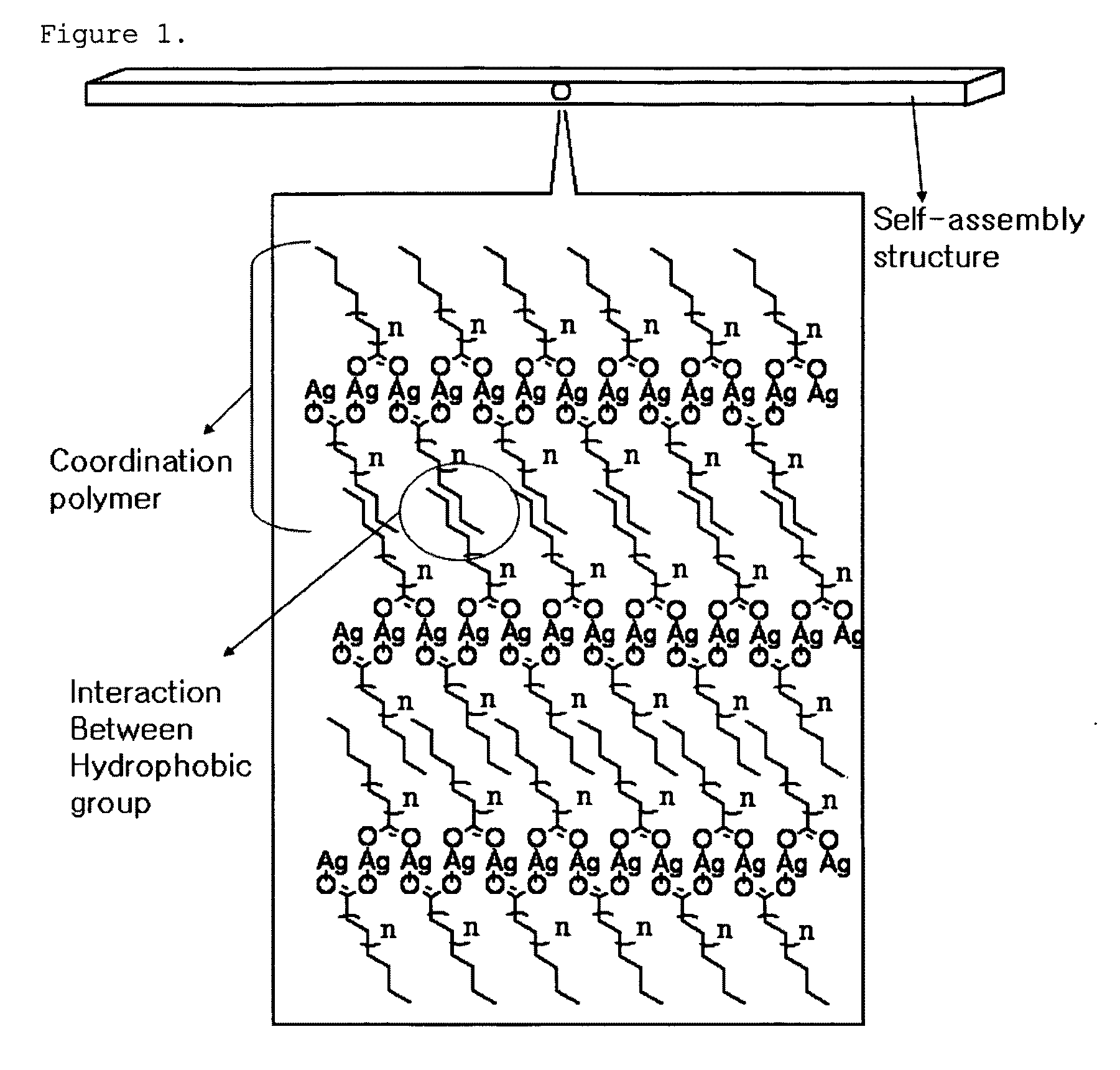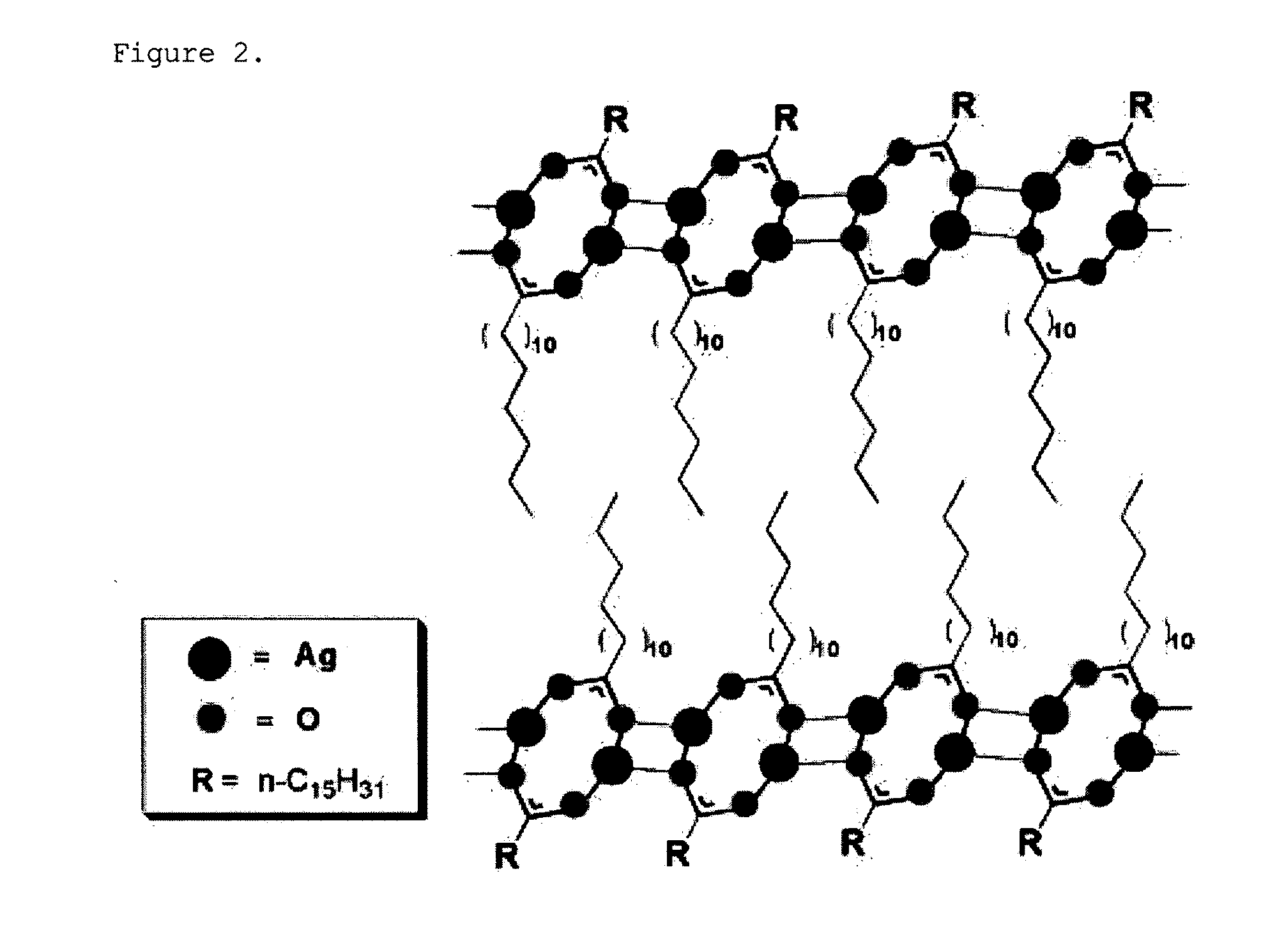Organic-inorganic hybrid structures having nanoparticles adhering thereon and method for preparing the same
- Summary
- Abstract
- Description
- Claims
- Application Information
AI Technical Summary
Benefits of technology
Problems solved by technology
Method used
Image
Examples
example 1
[0086]0.79 g of Ag-palmitate and 0.61 g of TEA (triethylamine) were dissolved in 50 ml of a toluene solvent, and the solution was refluxed at 110 C for 30 minutes, while N2 gas was bubbled through the solution. As a result, a red-colored dispersion could be obtained, and 50 ml of acetone was added thereto. The resulting solution was washed, stirred, and centrifuged at 3400 rpm for 3 minutes. Then, 50 ml of hexane was added thereto, and the solution was washed, stirred, and centrifuged at 3400 rpm for 3 minutes.
[0087]FIG. 3 schematically shows the process in which Ag nanoparticles are attached to the surface of a self-assembled structure of Ag-palmitate coordination polymer in this Example.
[0088]The Ag-palmitate dissolved in the solvent forms Ag nanoparticles by the reducing agent, and the palmitate separated during the reduction of Ag is attached to the surface of the Ag nanoparticles so as to serve as a surfactant, such that stable nanoparticles can be formed. Meanwhile, surplus Ag...
example 2
[0093]5.6 g of palmitic acid was added to 40 ml of triethylamine and stirred for 20 minutes, and 3.6 g of AgNO3 was added thereto. Then, the mixture was stirred for 2 hours to obtain a white slurry. The slurry was refluxed at about 80° C. for 2 hours and cooled. Then, 20 ml of acetone was added thereto, and the solution was centrifuged at 3200 rpm for 5 minutes to obtain Ag nanoparticles. The yield of the obtained Ag nanoparticles was 95%.
[0094]Meanwhile, 0.056 g of Ag-palmitate was dissolved in 25 g of a toluene solvent, and the solution was refluxed at 120° C. for 30 minutes, and then cooled to room temperature. As a result, a dispersion of a self-assembled structure of Ag-palmitate coordination polymer, having no nanoparticles attached thereto, could be obtained.
[0095]To the dispersion of the self-assembled structure dispersed therein, 0.005 g of the above-prepared Ag nanoparticles, which had a size of 5 nm or less and to which palmitic acid as a surfactant was attached to the su...
example 3
[0098]0.018 g of Ag-palmitate was dissolved in 25 g of a toluene solvent, and the solution was refluxed at 120° C. for 30 minutes, and then cooled to room temperature. As a result, a dispersion of a self-assembled structure of Ag-palmitate coordination polymer was dispersed could be obtained. To the dispersion, 0.050 g of ZnO nanoparticles, which had a size of 5 nm or less and to which palmitic acid as a surfactant was attached to the surface thereof, were added. The mixture was stirred for 30 minutes, and then centrifuged at 3400 rpm for 3 minutes.
[0099]FIG. 9 shows a transmission electron microscopy (TEM) photograph of the self-assembled structure of Ag palmitate coordination polymer, which was prepared in Example 3 and the surface of which was covered with ZnO nanoparticles. As can be seen in the TEM photograph, the component of the micro-scale wire was not ZnO, but coordination polymer, and ZnO nanoparticles having a size of about 5 nm were uniformly attached to the surface of t...
PUM
| Property | Measurement | Unit |
|---|---|---|
| Temperature | aaaaa | aaaaa |
| Length | aaaaa | aaaaa |
| Length | aaaaa | aaaaa |
Abstract
Description
Claims
Application Information
 Login to View More
Login to View More - R&D
- Intellectual Property
- Life Sciences
- Materials
- Tech Scout
- Unparalleled Data Quality
- Higher Quality Content
- 60% Fewer Hallucinations
Browse by: Latest US Patents, China's latest patents, Technical Efficacy Thesaurus, Application Domain, Technology Topic, Popular Technical Reports.
© 2025 PatSnap. All rights reserved.Legal|Privacy policy|Modern Slavery Act Transparency Statement|Sitemap|About US| Contact US: help@patsnap.com



